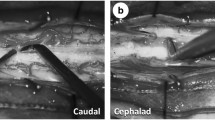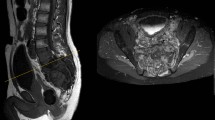Summary.
The result of the DREZotomy procedure used for the treatment of chronic intractable neuropathic pain caused by injuries at the T9-L4 spine level in 26 patients has been reported.
For the purpose of identifying the most favorable pain pattern for DREZ surgery we retrospectively analyzed the effectiveness of surgical treatment on different forms of pain in the follow-up period of 13–50 months, 37 months on average.
All pain forms were classified according to subjective sensory pain expression including the rhythm and topography of the pain.
Three groups of pain were formed according to subjective sensory equivalents: pain of thermal quality (burning, boiling, baking, warm etc.), pain of mechanical-nonthermal quality (shooting, cutting, stabbing, sharp, incisive, cramping, constriction, distraction, throbbing etc.). The third group was the combination of the previous two.
Success in pain relief has been defined as a 50% or greater reduction in pain after surgery such that pain no longer interferes with patient activities of daily living and sleeping pattern and no longer requires routine analgesic pain medication.
Our results revealed that the pain of mechanical-nonthermal nature and intermittent rhythm, confined to segmental topography was the most responsive to the DREZ surgical treatment so that 90% patients suffering from this pain pattern experienced a good long-term pain relief (70% had complete long term pain relief).
Neuropathic pain of thermal quality with the diffuse infralesional distribution and steady rhythm was the most resistant to the DREZ surgical treatment: neither patient had long-term relief of this pain pattern.
In the group of patients suffering from pain consisting of combined mechanical and thermal sensory components with confined pain territory, 75% experienced a good long-term pain relief (50% had complete long-term pain relief).
Immediate pain relief was obtained in 88% of patients and was long lasting in 69% of the total series.
Our results pointed to confined territory, intermittent rhythm and mechanical nature of the pain as the most relevant predictors of the expected pain relief achieved by the DREZ surgery.
Similar content being viewed by others
Author information
Authors and Affiliations
Rights and permissions
About this article
Cite this article
Spaić, M., Marković, N. & Tadić, R. Microsurgical DREZotomy for Pain of Spinal Cord and Cauda Equina Injury Origin: Clinical Characteristics of Pain and Implications for Surgery in a Series of 26 Patients. Acta Neurochir (Wien) 144, 453–462 (2002). https://doi.org/10.1007/s007010200066
Issue Date:
DOI: https://doi.org/10.1007/s007010200066




